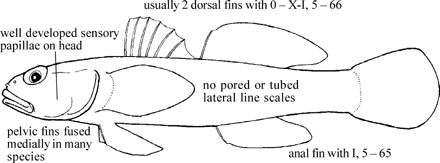GOBIIDAE
Gobies
By Koichi Shibukawa
|
Small to moderate-sized fishes, found in marine, brackish or freshwater areas. Body shape highly variable, but, typically, moderately elongate and more or less compressed posteriorly; no pored or tubed lateral-line scales on body. Teeth typically conical (flattened and incisor-like in some genera), forming a single to several rows in each jaw; minute sensory papillae well developed on head (and few on body and caudal fin), forming transverse or longitudinal rows; five branchiostegal rays. Usually two dorsal fins, first one with 0 - X flexible spines, second one usually with I spine and 5 - 66 soft rays; anal fin usually with I flexible spine and 5 - 65 soft rays; pectoral fin with 12 - 65 soft rays; dorsal and anal fin spines usually narrow and flexible; pelvic fins fused medially, exclusive of several coral reef genera with separated ones; pelvic fin usually with I spine and 4 - 5 soft rays. Scales cycloid or ctenoid (with peripheral cteni only), minute to moderately large in size. Color: highly variable.
Similar families occurring in the area. Blenniidae: single dorsal fin (sometimes deep notch developed between spinous and soft portions); teeth incisor-like, forming single row in each jaw; pelvic fins separated. Callionymidae: preopercle with a strong spine; no scales on body; gill opening restricted to a small dorsal or dorsolateral pore. Eleotridae: pelvic fins separated; six branchiostegal rays. Platycephalidae: many short spines or bony tubercles on head; pelvic fins separated. Tripterygiidae: three dorsal fins; pelvic fins separated. |

|
|






















